2. 北京大学地球与空间科学学院, 北京 100871
2. School of Earth and Space Sciences, Peking University, Beijing 100871, China
喜马拉雅造山带的崛起是印度-欧亚大陆碰撞造山作用的结果,并伴随着广泛的高级变质作用和地壳深熔作用(Allégre et al., 1984; Hodges, 2000; Yin and Harrison, 2000;吴福元等, 2015; Zeng et al., 2011, 2015; Gao et al., 2017; Wang et al., 2015, 2017a;曾令森和高利娥, 2017; Zheng and Wu, 2018)。在新生代碰撞之前,印度大陆是冈瓦纳大陆的一部分,喜马拉雅地块位于东冈瓦纳大陆的北缘。了解印度大陆北缘的物质和构造属性有助于甄别哪些特征是欧亚大陆与印度大陆碰撞的产物,哪些是在碰撞之前就存在的继承性构造(Beaumont et al., 2001; Zeng et al., 2009; DeCelles et al., 2004; Gehrels et al., 2006a, 2011; Zhang et al., 2012; Palin et al., 2018; van Hinsbergen et al., 2019; Gao et al., 2019)。了解碰撞前喜马拉雅地块的物质组成、结构和来源,有助于解译新生代变质作用的性质和地壳深熔作用的源区组成,有助于冈瓦纳古大陆的重建(DeCelles et al., 2000; Miller et al., 2001; Gehrels et al., 2006b, 2011;许志琴等, 2005; Cawood et al., 2007; Li et al., 2010; Zhang et al., 2012; Wang et al., 2017; Martin, 2017; Palin et al., 2018; Gao et al., 2019)。
现今的喜马拉雅造山带(或喜马拉雅地块)由北向南主要分为特提斯喜马拉雅沉积岩系(Tethyan Himalayan Sequence, THS)、高喜马拉雅结晶岩系(Greater Himalayan Crystalline Sequence, GHCS)、低喜马拉雅岩系(Lesser Himalayan Sequence, LHS)和次喜马拉雅岩系(Sub-Himalayan Sequence, SHS)等四个构造单元,它们之间分别被藏南拆离系(South Tibetan Detachment System, STDS)、主中央逆冲断层(Main Central Thrust, MCT)和主边界逆冲断层(Main boundary Thrust, MBT)所分隔(图 1)。喜马拉雅地块包含大量原岩年龄为晚元古代到早古生代的花岗质片麻岩(Collins and Pisarevsky, 2005;许志琴等, 2005; Gehrels et al., 2006a, 2011; Cawood et al., 2007; Zeng et al., 2011, 2012; Wang et al., 2013b; Mottram et al., 2014; Gao and Zeng, 2014;高利娥等, 2015; Liu et al., 2016;丁慧霞等, 2017; Martin, 2017; Gao et al., 2019; Yoshida et al., 2019),表明了喜马拉雅地体在碰撞前经历过较广泛的晚元古代到早古生代构造岩浆事件。除此之外,在印度北部、喜马拉雅造山带和拉萨地块内都发育寒武系与奥陶系角度不整合接触(DeCelles et al., 2000; Myrow et al., 2003, 2010, 2016, 2018; Liu et al., 2019; Gehrels et al., 2006b, 2011; Long et al., 2011; McQuarrie et al., 2008, 2013; Hughes et al., 2019)。早古生代岩浆作用记录和构造角度不整合都指示冈瓦纳大陆北缘在早古生代发生过一期重要的构造事件。不同学者们提出了不同的模型,来解释印度大陆北缘与相邻地块的构造演化关系,归结起来主要有两类模型:第一类模型是安第斯型俯冲模型(Gehrels et al., 2006b, 2011; Cawood et al., 2007; Palin et al., 2018),认为印度大陆北缘在早古生代由被动陆缘转变为主动陆缘,原特提斯洋向南俯冲,发生增生造山作用。奥陶纪之后又转为被动陆缘,形成寒武系-奥陶系角度不整合。另一些学者虽然提出了稍微不同的模型(Zhu et al., 2012; Wang et al., 2016; Martin, 2017; Yoshida et al., 2019),但都是在该模型的基础之上提出的,主要差异在邻区地块的空间方位和构造背景。第二类模型是被动陆缘演化模型(Brookfield, 1993; Mottram et al., 2014; Liu et al., 2019, 2020),认为从晚元古代末期到早古生代,印度大陆北缘没有经历过原特提斯洋的俯冲,一直处于被动陆缘状态,认为在该时期的岩浆-构造事件与裂谷闭合或者岩石圈减薄相关。为了探究晚元古代和早古生代岩浆-构造事件成因,本次研究采集了喜马拉雅造山带东部错那县麻玛沟地区的花岗片麻岩和淡色花岗岩,开展了锆石SHRIMP U-Pb定年和主、微量元素测试,结合前人数据来探讨晚元古代到早古生代印度大陆北缘构造演化过程。
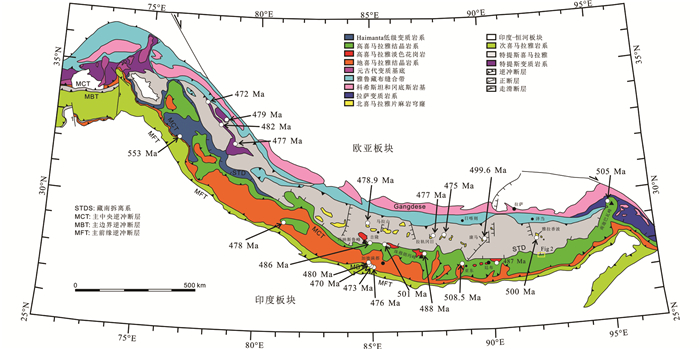
|
图 1 喜马拉雅造山带地质简图(据Guillot et al., 2008; Zeng et al., 2011; Zhang et al., 2017修改) 图中年龄数据来源于表 3 Fig. 1 Simplified geological map of Himalayan orogen (modified after Guillot et al., 2008; Zeng et al., 2011; Zhang et al., 2017) Age data in Fig. 1 from Table 3 |
喜马拉雅造山带的四个构造单元中,THS和LHS为浅变质或未变质的大陆边缘相沉积岩系(Myrow et al., 2003, 2016; Gehrels et al., 2011; Hughes et al., 2019)。其中THS整体上以海相沉积为主,并夹有少量陆相碎屑沉积,并且寒武系-奥陶系角度不整合普遍存在(周志广等, 2004; Myrow et al., 2018),典型剖面有Zanskar、Spiti和康马地区等。而LHS中陆相和过渡相沉积占大部分,少部分为浅海碳酸盐相,也存在寒武系-奥陶系不整合,如Ambar和Swabi地区(Myrow et al., 2018)。在巴基斯坦和苏丹局部地区的寒武系与晚于奥陶系的更年轻地层不整合接触(Long et al., 2011; Myrow et al., 2016)。SHS为喜马拉雅造山带的前陆盆地,除了上部少量新生代沉积外,下部地层与LHS相似(Thakur et al., 2007),但是除了巴基斯坦的Salt Range地区,沿造山带走向的其他地区都还没有发现有寒武系地层出露,而Salt Range和印度克拉通北部的Rajasthan地区都存在寒武系-二叠系不整合接触(Hughes et al., 2019)。GHCS的变质程度普遍达到了角闪岩相以上,阻碍了原生层序的划分,在该构造单元的来源上的认识存在较大分歧(DeCelles et al., 2000;张泽明等, 2008a, b ; Myrow et al., 2003, 2010, 2016, 2018; Hughes et al., 2019)。GHCS的划分方法有多种(Wang et al., 2013a),本文参照更为简便的Le Fort (1975)的划分方法,即GHCS按照变质程度和矿物共生组合等特征由下到上划分成三组,组-1为含蓝晶石-石榴石变泥质岩、混合岩和石英岩;组-2主要为含石榴子石-透辉石大理岩和钙硅酸盐类;组-3为含夕线石变长英质岩,夹杂少量钙硅酸盐类,并且含有大量正片麻岩。
本次研究的采集的样品为STDS以南的GHCS组-3花岗片麻岩类和淡色花岗岩,采样地点位于错那县南部的麻玛沟地区(图 2);STDS以北为错那裂谷带,广泛分布近东西走向的辉绿岩脉(Wang et al., 2018)和规模不等的淡色花岗岩体(高利娥等, 2012;王晓先等, 2016;石卿尚等, 2017)。MM15系列样品为含石榴子石花岗片麻岩,MMG-LG和T0713为淡色花岗岩。花岗片麻岩(MM15)的主要矿物为石英、钾长石、斜长石、黑云母、石榴子石和少量白云母(图 3a, b),其中黑云母定向,斜长石、钾长石和石榴子石呈半定向结构,在野外露头上显示出片麻状构造特征。其中黑云母半自形-他形结构,多呈长柱状或条状,部分形态不规则的颗粒生长在斜长石周围;斜长石和钾长石为半自形-他形的板状结构,且钾长石颗粒相对较大;石榴子石他形粒状结构,裂隙发育。由于该岩体与围岩共同经历了高级变质作用事件,因此二者的边界难以准确界定。
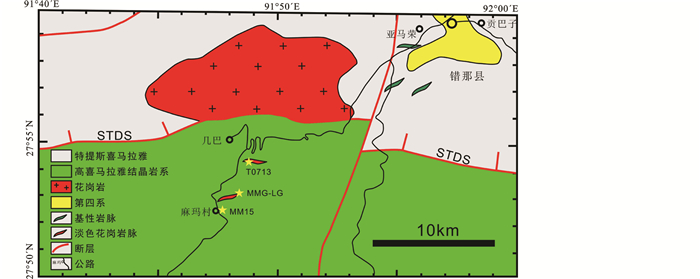
|
图 2 西藏南部错那地区地质简图(据丁慧霞等, 2017修改) Fig. 2 Simplified geological map of the Cona area, South Tibet (modified after Ding et al., 2017) |
淡色花岗岩(MMG-LG和T0713)产状为脉体,斜切围岩的片理或片麻理。2条脉体除了钾长石颗粒大小不同外,其他矿物组合、结构和含量均相同,都为含石榴子石淡色花岗岩(图 3c, d)。主要矿物为石英、钾长石、斜长石、石榴子石和少量云母,石榴子石大部分为他形粒状结构,其核部包裹钾长石、石英等矿物,所有矿物没有明显的定向,表明这些脉体没有受到明显的构造变形的影响。样品MMG-LG中的钾长石大小相对不均一,为0.01~1mm之间;样品T0713中的钾长石颗粒大小相对均一,大部分颗粒位于0.1~0.5mm之间。从岩相学上,花岗片麻岩和淡色花岗岩明显不同,前者黑云母含量较多,石榴子石含量较少,而淡色花岗岩反之。

|
图 3 麻玛沟花岗片麻岩(a、b)和淡色花岗岩(c、d)显微照片 (a、b)为样品MM15;(c)为样品MMG-LG;(d)为样品T0713. Gt-石榴子石;Kf-钾长石;Pl-斜长石;Bi-黑云母;Q-石英 Fig. 3 Microphotographs of the granitic gneiss (a, b) and the leucogranite (c, d) from the Mama Valley (a, b) Sample MM15; (c) Sample MMG-LG; (d) Sample T0713. Gt-garnet; Kf-K-feldspar; Pl-plagioclase; Bi-biotite; Q-quartz |
样品的全岩主微量元素测试在自然资源部国家地质实验测试中心进行,其中主量元素通过X射线荧光法(XRF)进行测定,仪器型号为Rigaku-3080,分析精度优于5%;微量元素利用等离子质谱仪(ICP-MS)进行分析,仪器型号为Finigan ELEMENT 2 ICP-MS,其分析精度可保持在5%~10%。
2.2 锆石SHRIMP U-Pb年龄锆石同位素年龄测试和锆石靶的制作在北京离子探针中心进行,采用高分辨率二次离子探针质谱仪(SHRIMPⅡ)进行测定,离子源为氧源,粒子流强度为4nA,束斑直径约为25μm×15μm,仪器质量分辨率为5000。锆石标样采用M257(U:846×10-6)和TEM(417Ma)双标样标定,分别标定U含量和年龄。样品测定时,每测定5个样品点进行一次标样测定,每个测试点之间最短为180秒,用以测定后通道内的清洗。锆石靶的制作流程可参见宋彪等(2002)。
3 分析结果 3.1 主量元素特征两种岩石中,淡色花岗岩(MM15)的SiO2(73.94%~75.08%)、Na2O(3.41%~4.12%)、K2O(4.02%~5.55%)含量最高,TiO2(0.01%~0.22%)、FeO+Fe2O3(0.44%~1.59%)、MgO(0.11%~0.35%)、CaO(0.53%~1.31%)含量最低,并具有较高的Al2O3(13.44%~14.51%),K2O/Na2O(1.14~1.44)和A/CNK(1.08~1.13)比值都较高,表明该岩石为富钾过铝质花岗岩(表 1、图 4)。
|
|
表 1 麻玛沟花岗岩和变泥质岩主量(wt%)及微量(×10-6)元素数据 Table 1 Major (wt%) and trace (×10-6) element data of granite and metapelite from Mama Valley |

|
图 4 麻玛沟花岗片麻岩和淡色花岗岩主量元素关系图解 Fig. 4 Major element diagrams for the granitic gneisses and the leucogranites from the Mama Valley |
花岗片麻岩(T0713、MMG-LG),SiO2含量在72.44%~74.60%之间,具有较高的Al2O3(12.63%~13.48%)、Na2O(2.58%~2.85%)、K2O(4.02%~4.73%)和较低的TiO2(0.27%~0.30%)、FeO+Fe2O3(2.90%~3.18%)、MgO(0.56%~0.63%)、CaO(1.42%~1.67%)含量,其K2O/Na2O比值很高,位于1.50~1.83之间,A/CNK值在1.09~1.11之间,也属于富钾过铝质花岗岩(表 1、图 4)。
3.2 微量元素特征花岗片麻岩的球粒陨石标准化稀土元素曲线右倾(图 5a),其富集程度低于A型花岗岩的平均值,且具有较低的(La/Yb)N(4.30~5.89)比值,较大的Eu负异常(Eu/Eu*=0.28~0.36);从微量元素(表 1、图 5b、图 6)中可看出,这些样品富集Cs(6.33×10-6~7.01×10-6)、Rb(229×10-6~264×10-6)、Th(25.9×10-6~31.8×10-6)、U(5.6×10-6~7.61×10-6)、Pb(35.1×10-6~47.6×10-6)、Nb(11.4×10-6~12.6×10-6)、Ta(1.33×10-6~1.64×10-6),亏损Sr(56.7×10-6~62.8×10-6)。

|
图 5 麻玛沟花岗片麻岩和淡色花岗岩的球粒陨石标准化稀土元素配分图(a, 标准化值据Anders and Grevesse, 1989)和原始地幔标准化微量元素蛛网图(b, 标准化值据Sun and McDonough, 1989) A型花岗岩数据引自Wu et al. (2002),图 6同 Fig. 5 Chondrite-normalized REE patterns (a, normalization values after Anders and Grevesse, 1989) and primitive mantle-normalized trace element spider diagrams (b, normalization values after Sun and McDonough, 1989) for the granitic gneisses and the leucogranites from the Mama Valley Data of A-type granite from Wu et al. (2002), also in Fig. 6 |
淡色花岗岩的稀土元素含量变化较大(图 5a),其REE标准化曲线形态各异,富集程度不及花岗片麻岩和A型花岗岩。MMG-LG呈现出右倾趋势((La/Yb)N=12.79),且具有较明显的Eu负异常(Eu/Eu*=0.63),相对富集轻稀土元素(LREE),亏损重稀土元素(HREE)。T0713-15-LG的REE标准化曲线为近水平((La/Yb)N=1.02),较明显的Eu负异常(Eu/Eu*=0.52)。T0713的REE标准化曲线总体右倾((La/Yb)N=2.46~4.69),具微弱的Eu正异常(Eu/Eu*=1.17~1.18)和Ce负异常(Ce/Ce*=0.87~0.88),LREE和HREE相对富集,而中稀土(MREE)相对亏损。淡色花岗岩的微量元素(图 6)含量总体上也富集Cs(1.38×10-6~15.5×10-6)、Rb(150×10-6~353×10-6)、U(1.29×10-6~16×10-6)、Pb(31×10-6~87.4×10-6),但相对亏损Th(0.15×10-6~16.2×10-6)、Nb(1.57×10-6~12.8×10-6)、Ta(0.07×10-6~2.22×10-6)、Sr(9.75×10-6~96.3×10-6)。
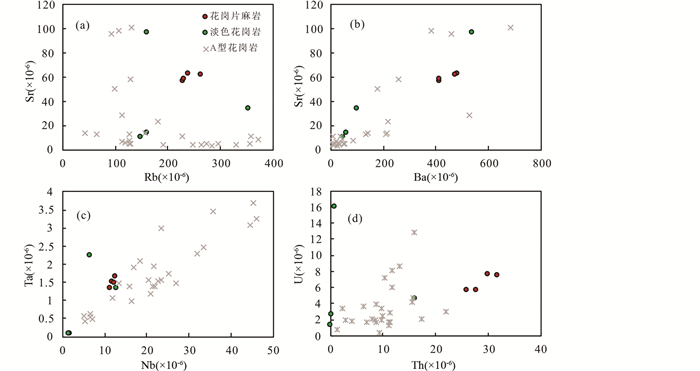
|
图 6 麻玛沟花岗片麻岩和淡色花岗岩的Rb-Sr (a)、Ba-Sr (b)、Nb-Ta (c)和Th-U (d)图解 Fig. 6 Rb vs. Sr (a), Ba vs. Sr (b), Nb vs. Ta (c) and Th vs. U (d) diagrams for the granitic gneisses and the leucogranites from the Mama Valley |
花岗片麻岩样品的锆石颗粒(图 7a)为长柱状,其长轴/短轴的值在2~7之间,平均值约为3.5,自形-半自形结构,锆石CL图像显示内部呈韵律环带结构,显示岩浆锆石的特征,部分锆石的边部颜色比核部更深,说明到锆石结晶后期U、Th含量增加。部分颗粒边部均匀无韵律环带,可能代表了后期变质作用的结果。从结构来看,锆石内部的韵律环带部分记录了该岩石的结晶年龄,而边部分可能是记录了该岩体后期变质作用的年龄,但边部太窄,小于SHRIMP束斑大小,无法获取有地质意义的年龄。对该样品,选择了20颗锆石,进行了27点测试(表 2),测试结果显示这些锆石的U(208×10-6~11945×10-6)和Th(49×10-6~506×10-6)的含量变化较大,具有高U效应,Th/U比值在0.04~0.61之间,206Pb/238U年龄除了点6.1(937Ma)和17.2(279.4Ma)外,集中在481.8~541.5Ma之间(图 8a)。点6.1的锆石为继承锆石,其Th/U比值为0.18,锆石核为新元古代的岩浆锆石,点17.2可能是锆石的环带部分与反应边的混合年龄,因此其年龄远小于平均年龄,剔除这2个点后的加权平均年龄为500.7±4.5Ma(N=25,MSWD=1.9)。所有的点均位于或近似位于谐和线上,没有明显的Pb丢失,为谐和年龄,代表该岩体的岩浆结晶年龄。
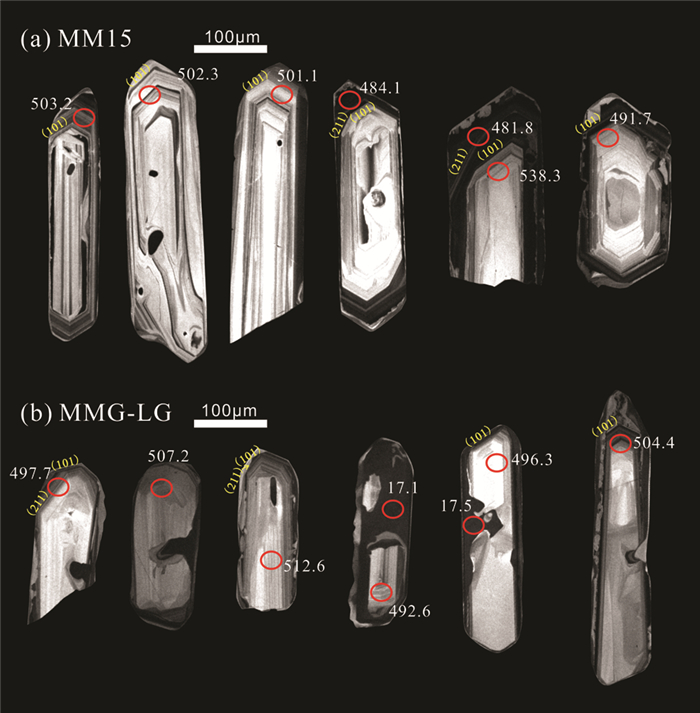
|
图 7 麻玛沟花岗片麻岩和淡色花岗岩样品的锆石阴极发光图像 圆圈代表激光剥蚀位置,数字代表年龄(Ma);括号内数字代表晶面符号 Fig. 7 Cathodoluminescence (CL) image of the zircon grains for granitic gneiss and leucogranite from Mama Valley The circles stand for the ablated locations by laser, the numbers stand for age (Ma); the numbers in brackets are symbol of crystal face |
|
|
表 2 麻玛沟花岗片麻岩和淡色花岗岩锆石SHRIMP U-Pb年龄 Table 2 SHRIMP zircon U-Pb data for granitic gneiss and leucogranite from Mama Valley |
淡色花岗岩样品的锆石颗粒形态与花岗片麻岩类似(图 7b),均为长柱状,长轴/短轴的值为1~5.5之间,平均值约为3.0,半自形-他形结构,CL图像显示其内部结构也普遍具有韵律环带结构,且边部的环带变暗。但与花岗片麻岩的锆石不同的是,该样品的部分锆石颗粒发育核-幔-边结构或核-边结构。其中核部为具有环带结构的岩浆锆石,为锆石的主体部分,U(322×10-6~4061×10-6)和Th(32×10-6~1257×10-6)含量变化较大(表 2),Th/U比值在0.01~0.66之间,206Pb/238U年龄除了点1.2(427.5Ma)和13.1(238.1Ma)离群外,集中在488.5~512.6Ma之间(图 8c, d)。点1.2和13.1的年龄均小于平均年龄,推测为核部与慢部(或边部)的混合年龄,将两点的年龄剔除后,核部的加权平均年龄为498.6±3.4Ma(N=16,MSWD=0.88),所有的点都位于或近似位于谐和线上,为谐和年龄,无明显的Pb丢失。CL图像显示锆石的幔部无环带,呈现出较均匀的深灰色调,U(2539×10-6~4194×10-6)和Th(10×10-6~89×10-6)含量变化相对较小,无明显高U效应,Th/U比值很低,在0.001~0.03之间,但绝大多数的值为0.01,这是淡色花岗岩中结晶锆石的通性(曾令森等, 2019),206Pb/238U年龄集中在15.7~25.1Ma之间,但是年龄数据比较分散(图 8b),给出的加权年龄无太大意义,需要结合相邻淡色花岗岩的年龄数据进行讨论(见下文讨论部分)。该样品锆石的边部无环带或不明显的环带,总体上边部显示灰色的亮边,与暗灰色的幔部区别开来,边部厚度很小,个别锆石颗粒出现了边部而幔部不发育,还有极少的锆石出现了幔部而边部不发育,而核部几乎出现在每颗锆石中,且占锆石颗粒的主要部分,控制着锆石再生长过程中的大致的几何形状,有些锆石可见核部被幔部侵蚀成港湾状(例如图 7b的前两颗锆石)。因此我们判断核部为继承锆石,其年龄代表淡色花岗岩形成之前的岩浆作用事件;幔部和边部为淡色花岗岩岩浆结晶作用的产物,其中幔部为结晶峰期时形成,而边部为结晶末期形成。

|
图 8 麻玛沟花岗片麻岩(a)和淡色花岗岩(b-d)的锆石U-Pb年龄谐和图 Fig. 8 Zircon U-Pb Concordia diagram for the granite gneiss (a) and the leucogranite (b-d) from Mama Valley |
利用CL图像,我们可以观察锆石晶面中锥面的发育情况(Pupin, 1980; Vavra, 1990, 1993; Li et al., 2014),如果锆石颗粒发育(101)锥面,则锆石尖端角度较大,呈钝角或近直角形态,如果(211)锥面发育,则锆石尖端呈锐角。由于CL图像为二维图像,锆石的柱面类型不容易区分,但是可以观察其长轴/短轴的比值。通过对比,花岗片麻岩(MM15)和淡色花岗岩(MMG-LG)样品中的锆石形态相近(图 7),主要表现为:长轴/短轴比值相近,其平均值在3~3.5之间;锆石晶面发育相近,两种锆石均发育(101)锥面,(211)锥面发育较差。Pupin (1980)利用花岗岩中的锆石形态对其进行成因分类,主要分成壳源的过铝质淡色花岗岩、二长花岗岩、花岗闪长岩,壳幔混合型的亚碱性、钙碱性花岗岩,和幔源的碱性、拉斑玄武系列的花岗岩。样品中的锆石形态特征符合壳源成分的过铝质花岗岩,与岩石的化学成分分类相吻合,表明花岗片麻岩从岩浆作用开始到现在,虽然经历过较强烈的变质作用,但其全岩主量元素成分变化不大。而淡色花岗岩中的锆石核部占有很大比重,控制了增生后锆石的整体形态,因此花岗片麻岩中的锆石与淡色花岗岩中的锆石核部形态相近。
麻玛沟的花岗片麻岩加权平均年龄为500.7Ma(图 8a);淡色花岗岩继承锆石的加权平均年龄为498.6Ma(图 8c, d)。这些年龄与前人报道的印度大陆北缘的早古生代岩浆事件相吻合(Cawood et al., 2007; Zhu et al., 2012; Gao et al., 2019),为同一期构造岩浆事件的产物。从锆石的形态学分类可看出麻玛沟地区花岗片麻岩和淡色花岗岩都属于造山型的过铝质花岗岩,而非岩石圈减薄过程中产生的钙碱性或碱性火成岩。
4.1.2 地球化学分析虽然目前精准判别花岗岩的构造环境仍有困难(Pitcher, 1997;吴福元等, 2007),但不同构造环境下的花岗岩总体上还是具有明显的差异性(吴福元等, 2007;舒良树和王博, 2019)。本文的两种花岗岩都属于过铝质花岗岩,部分非造山和造山后花岗岩也会出现过铝质特征(Pitcher, 1997; Wu et al., 2002;吴福元等, 2007),但其微量元素特征能够较好地区分过铝质花岗岩是否是造山型过铝质花岗岩。例如非造山的A型花岗岩比造山型过铝质花岗岩的U、Th、Sr和Ba含量要低,具有更高的Zr、Hf和Nb/Ta比值,(图 5b、图 6;Wu et al., 2002),通常具有非常显著的Eu负异常和较高(La/Yb)N比值,与麻玛沟花岗片麻岩的稀土配分曲线差异较大(图 5a)。进一步地,在新元古代早期(约800Ma)也发生过大规模的岩浆作用时间,普遍认为是Rodinia超大陆裂解的产物(Singh et al., 2002; Ding and Zhang, 2016; Wang et al., 2016, 2017b;王一伟等, 2016; Spencer et al., 2019;董昕和田作林, 2019),这些新元古代岩浆岩的锆石Th/U比值明显高于本文早古生代花岗岩的数据(图 9),说明二者的形成环境不同。上述分析表明,早古生代过铝质花岗岩可能是造山型过铝质花岗岩,不是拉张环境下的非造山特征,支持前文所述的安第斯型俯冲模型。
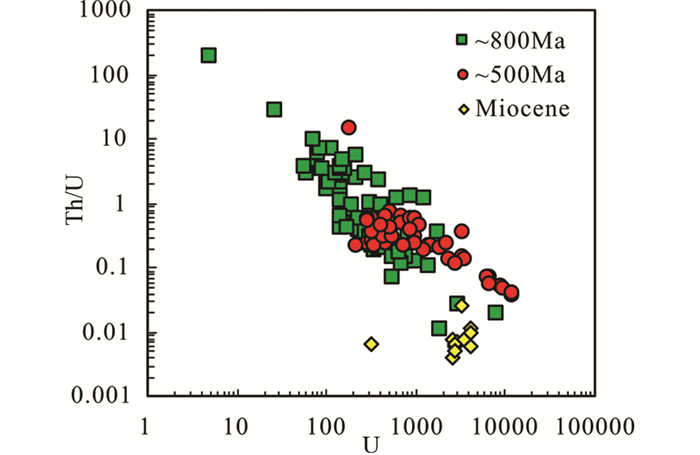
|
图 9 麻玛沟花岗片麻岩和淡色花岗岩锆石U-Th/U图解 800Ma的数据来源于Wang et al. (2017),其他数据来源于表 2 Fig. 9 Diagram of U vs. Th/U for zircon from granitic gneiss and leucogranite from Mama Valley Except for the data of 800Ma after Wang et al. (2017), others are from Table 2 |
喜马拉雅造山带保存着大量的晚元古代-早古生代岩浆作用的纪录(图 1、表 3),分布于THS、GHCS和LHS等三个构造单元,从东构造节的南迦巴瓦地区到西部的巴基斯坦地区均有出露。如前所述,印度大陆北缘早古生代岩浆作用可能是原特提斯洋俯冲作用的结果,在俯冲作用发生之前,印度大陆与原特提斯洋是被动陆缘的连接模式(Cawood et al., 2007; Zhu et al., 2012; Gao et al., 2019)。因此,在新元古代到早古生代期间,其板块边缘必定发生了从离散状态到会聚状态的构造转换,从而导致原特提斯洋开始向印度大陆俯冲,那么,相对于印度大陆,原特提斯洋初始俯冲是正向俯冲,还是从一侧俯冲后逐渐扩展到另一侧?针对该问题,笔者整理了喜马拉雅造山带晚元古代-早古生代花岗岩年龄数据(表 3),发现从喜马拉雅造山带西部到东部(图 10),除了Kaplas地区的花岗岩外,其他花岗岩的年龄均匀变大的趋势,如图 10中黄色箭头线所示,从约470Ma增大到510Ma左右,间隔约40Myr,预示着东部的岩浆活动要早于西部,原特提斯洋初始俯冲从东部开始,并逐渐向西部扩展。印度大陆北缘在经历岩浆作用的同时必然也经历了强烈的变质作用事件,GHCS内的变质岩可能会残留早古生代变质作用的痕迹。
|
|
表 3 喜马拉雅造山带的花岗岩锆石U-Pb年龄数据 Table 3 U-Pb age data of granite from Himalayan orogen |
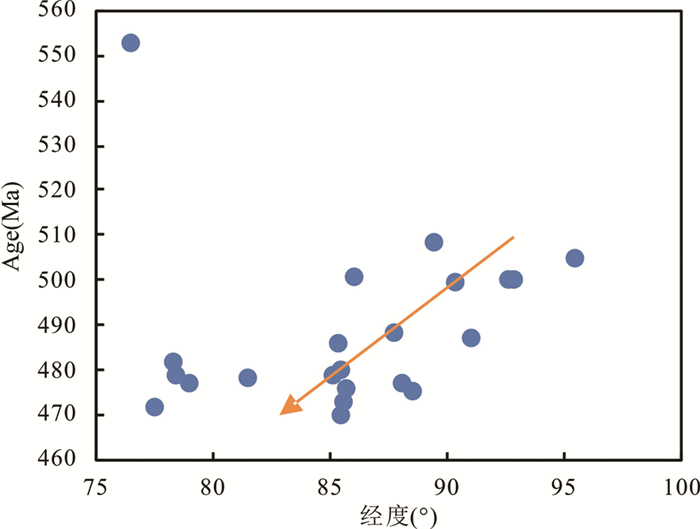
|
图 10 喜马拉雅造山带花岗岩锆石U-Pb年龄分布图 数据来源于表 3 Fig. 10 Zircon U-Pb age of granite from the Himalayan orogen The data is from Table 3 |
喜马拉雅造山带中新世淡色花岗岩分布广泛,在THS和GHCS构造单元内均有出露,构成喜马拉雅造山带新生代花岗岩的主体部分(吴福元等, 2015;曾令森和高利娥, 2017),其形成机制主要有两种(Inger and Harris, 1992; Gao et al., 2014;曾令森和高利娥, 2017):
(1) 白云母脱水熔融:22Ms+7Pl+8Qz=25Melt+5Kf+5Sil+2Bt
(2) 水致白云母熔融:9Ms+15Pl+7Qz+xH2O=31Melt
其中Ms为白云母,Pl为斜长石,Qz为石英,Melt为熔体,Kf为钾长石,Sil为夕线石,Bt为黑云母。
如上文所述,麻玛沟淡色花岗岩的结晶年龄在15.7~25.1Ma之间,为了探讨其形成机制,本文整理了邻近的三个淡色花岗岩体(亚马荣淡色花岗、错那洞淡色花岗岩和雅拉香波淡色花岗岩)年龄(图 11)和Ba-Rb/Sr关系数据(图 12)。这四套淡色花岗岩近似位于同一经度,最南端为麻玛沟淡色花岗岩,最北端为雅拉香波淡色花岗岩,其中麻玛沟和亚马荣为高喜马拉雅淡色花岗岩,而错那洞和雅拉香波为THS单元内与穹窿构造相伴生的淡色花岗岩。
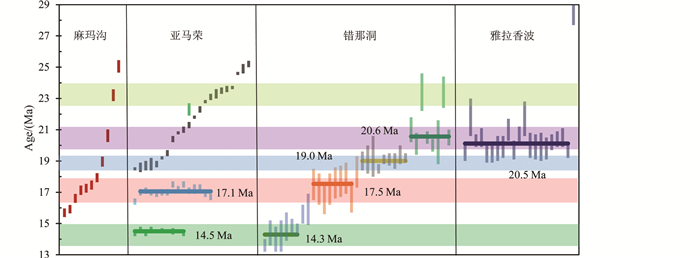
|
图 11 麻玛沟、亚马荣、错那洞和雅拉香波的中新世淡色花岗岩的锆石U-Pb加权年龄分布 数据来源:亚马荣据Aikman et al. (2008)和石卿尚等(2017);错那洞据Fu et al. (2018);雅拉香波据曾令森等(2019) Fig. 11 Zircon U-Pb weighted average ages for the Miocene leucogranite from the Mama Valley, Yamarong, Conadong and Yardoi Data source: the Yamarong from Aikman et al. (2008) and Shi et al. (2017); the Conadong from Fu et al. (2018); the Yardoi from Zeng et al. (2019) |
根据整理的年龄数据(图 11)可知,该地区的淡色花岗岩至少可分为5个期次,分别为1(~23Ma)、2(~20.5Ma)、3(~19Ma)、4(~17Ma)和5(~14Ma),其中第一期在错那洞和雅拉香波淡色花岗岩中不发育,说明中新世淡色花岗岩岩浆可能在GHCS地区先形成,随后才在THS地区出现,但是热源并不是从南向北逐渐扩展,因为后四个期次大部分中新世淡色花岗岩中都能见到(曾令森和高利娥, 2017; Gao et al., 2017),因此至今大部分学者认为GHCS和THS地区的中新世淡色花岗岩的成因机制相似(吴福元等, 2015;石卿尚等, 2017;王晓先等, 2016)。Ba-Rb/Sr系统关系(图 12)显示四个区域的淡色花岗岩为主要为白云母脱水熔融的产物(Inger and Harris, 1993; Patiño Douce and Harris, 1998;黄春梅等, 2018),但不排除部分淡色花岗岩为水致白云母熔融成因(Le Fort, 1975; Gao and Zeng, 2014; Gao et al., 2017)。麻玛沟、亚马荣、错那洞和雅拉香波位于南北走向的错那裂谷带中,其成因机制主要为白云母脱水熔融,在邻近区域也发现了水致白云母熔融成因的18Ma左右的淡色花岗岩体(高利娥等, 待发表数据),因此喜马拉雅中新世淡色花岗岩可能是两种形成机制共同作用的结果,并导致其岩浆活动至少有五个期次。
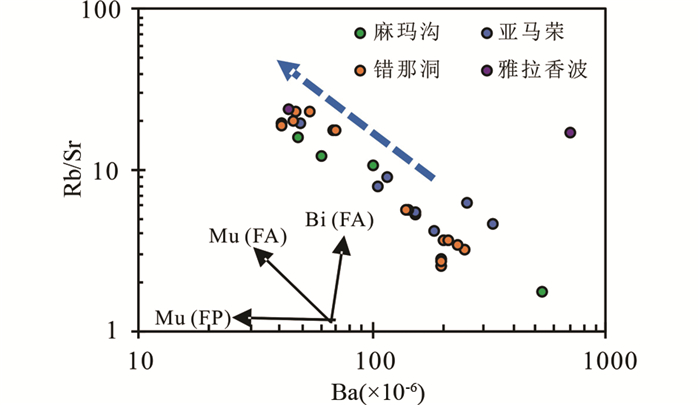
|
图 12 麻玛沟、亚马荣、错那洞和雅拉香波的中新世淡色花岗岩的Ba-Rb/Sr图解 数据来源:亚马荣据石卿尚等(2017);错那洞据Xie et al. (2018)和黄春梅等(2018);雅拉香波据曾令森等(2019) Fig. 12 Ba vs. Rb/Sr diagram for the Miocene leucogranite from the Mama Valley, Yamarong, Conadong and Yardoi Data source: the Yamarong from Shi et al. (2017); the Conadong from Xie et al. (2018) and Huang et al. (2018); the Yardoi from Zeng et al. (2019) |
大量野外和实验数据表明,喜马拉雅造山带绝大多数淡色花岗岩的源岩为变沉积岩。与沉积岩中碎屑锆石普遍具有分散的年龄特征不同,麻玛沟淡色花岗岩的继承锆石年龄非常集中(图 8c, d),更像岩浆岩中的锆石年龄特征。同时,麻玛沟淡色花岗岩的锆石与本文报道的花岗片麻岩的锆石形态特征相近(图 7),因此我们推测麻玛沟淡色花岗岩的源岩可能是晚元古代-早古生代花岗质片麻岩。
与多数变泥质岩相比,晚元古代-早古生代花岗岩的原岩白云母含量明显较低,即使发生白云母脱水部分熔融作用,形成的岩浆规模有限。与喜马拉雅造山带其他地区的中新世淡色花岗岩相比,麻玛沟淡色花岗岩的(La/Yb)N比值较低,具更显著的Eu负异常(图 5a),但K2O/Na2O比值和K2O等主量元素含量相近(图 4)。如果麻玛沟淡色花岗岩的源区为晚元古代-早古生代花岗质片麻岩白云母脱水熔融的产物,那么这些脉状产出的淡色花岗岩可能代表花岗质片麻岩低度部分熔融的产物。
5 结论本文通过对错那县麻玛沟的花岗片麻岩和淡色花岗岩进行锆石SHRIMP U-Pb年龄和全岩成分的研究,并结合前人的数据,有如下认识:
(1) 本次研究得出麻玛沟花岗片麻岩和淡色花岗岩中继承锆石的结晶年龄分别为500.7±4.5Ma和498.6±3.4Ma,属于早古生代岩浆作用的产物。
(2) 通过岩石主量元素和锆石形态可知,麻玛沟花岗片麻岩和淡色花岗岩均为过铝质花岗岩,并相对富集Cs、Rb、U、Pb,亏损Zr、Hf、Nb/Ta等与非造山型或造山后花岗岩区别开来,属于造山型花岗岩,由此推知在早古生代期间印度大陆北缘为俯冲汇聚型大陆边缘。
(3) 结合前人数据推知,从晚元古代末期开始,印度大陆北缘从被动陆缘转变为主动陆缘,可能从东部开始俯冲,并逐渐向西部扩展,形成自东向西的俯冲模式。
(4) 麻玛沟淡色花岗岩可能为晚元古代-早古生代花岗岩低程度部分熔融的产物。结合前人数据,推测喜马拉雅中新世淡色花岗岩可能为白云母脱水熔融和水致白云母熔融共同作用的结果,并导致其岩浆活动至少有五个期次。
致谢 感谢中国地质科学院地质研究所董昕副研究员和中国科学院地质与地球物理研究所王佳敏副研究员审阅稿件,并提出诸多建设性意见和建议。
Aikman AB, Harrison TM and Lin D. 2008. Evidence for Early (>44Ma) Himalayan crustal thickening, Tethyan Himalaya, southeastern Tibet. Earth and Planetary Science Letters, 274(1-2): 14-23 DOI:10.1016/j.epsl.2008.06.038 |
Allégre CJ, Courtillot V, Tapponnier P, Hirn A, Mattauer M, Coulon C, Jaeger JJ, Achache J, Schärer U, Marcoux J, Burg JP, Girardeau J, Armijo R, Gariépy C, Göpel C, Li TD, Xiao XC, Chang CF, Li GQ, Lin BY, Teng JW, Wang NW, Chen GM, Han TL, Wang XB, Deng WM, Sheng HB, Cao YG, Zhou J, Qiu HR, Bao PS, Wang SC, Wang BX, Zhou YX and Xu RH. 1984. Structure and evolution of the Himalaya-Tibet orogenic belt. Nature, 307(5946): 17-22 DOI:10.1038/307017a0 |
Anders E and Grevesse N. 1989. Abundances of the elements: Meteoritic and solar. Geochimica et Cosmochimica Acta, 53(1): 197-214 DOI:10.1016/0016-7037(89)90286-X |
Beaumont C, Jamieson RA, Nguyen MH and Lee B. 2001. Himalayan tectonics explained by extrusion of a low-viscosity crustal channel coupled to focused surface denudation. Nature, 414(6865): 738-742 DOI:10.1038/414738a |
Brookfield ME. 1993. The Himalayan passive margin from Precambrian to Cretaceous times. Sedimentary Geology, 84(1-4): 1-35 DOI:10.1016/0037-0738(93)90042-4 |
Cawood PA, Johnson MRW and Nemchin AA. 2007. Early Palaeozoic orogenesis along the Indian margin of Gondwana: Tectonic response to Gondwana assembly. Earth and Planetary Science Letters, 255(1-2): 70-84 DOI:10.1016/j.epsl.2006.12.006 |
Collins AS and Pisarevsky SA. 2005. Amalgamating eastern Gondwana: The evolution of the Circum-Indian Orogens. Earth-Science Reviews, 71(3-4): 229-270 DOI:10.1016/j.earscirev.2005.02.004 |
DeCelles PG, Gehrels GE, Quade J, LaReau B and Spurlin M. 2000. Tectonic implications of U-Pb zircon ages of the Himalayan orogenic belt in Nepal. Science, 288(5465): 497-499 DOI:10.1126/science.288.5465.497 |
DeCelles PG, Gehrels GE, Najman Y, Martin AJ, Carter A and Garzanti CE. 2004. Detrital geochronology and geochemistry of Cretaceous-Early Miocene strata of Nepal: Implications for timing and diachroneity of initial Himalayan orogenesis. Earth and Planetary Science Letters, 227(3-4): 313-330 DOI:10.1016/j.epsl.2004.08.019 |
Ding HX and Zhang ZM. 2016. Neoproterozoic granitoids in the eastern Himalayan orogen and their tectonic implications. Precambrian Research, 285: 1-9 DOI:10.1016/j.precamres.2016.09.005 |
Ding HX, Zhang ZM, Li MM, Niu ZX and Zhang N. 2017. Metamorphism and tectonic significance of the Greater Himalayan Crystalline Sequence in Cona region, eastern Himalaya. Acta Petrologica Sinica, 33(8): 2357-2376 (in Chinese with English abstract) |
Dong X and Tian ZL. 2019. Multistage tectono-thermal events in the Yadong area of the Himalayan orogenic belt: Evidence from zircon and monazite U-Th-Pb geochronology. Acta Petrologica et Mineralogica, 38(4): 431-452 (in Chinese with English abstract) |
Fu JG, Li GM, Wang GH, Zhang LK, Liang W, Zhang Z, Zhang XQ and Huang Y. 2018. Synchronous granite intrusion and E-W extension in the Cuonadong dome, southern Tibet, China: Evidence from field observations and thermochronologic results. International Journal of Earth Sciences, 107(6): 2023-2041 DOI:10.1007/s00531-018-1585-y |
Gao LE, Zeng LS, Shi WG, Chen ZY, Hu MY and Sun DY. 2012. Two types of garnets in the Cenozoic granites from the Himayalan Orogenic Belt: Geochemical characteristics and implications for crustal anatexis. Acta petrologica Sinica, 28(9): 2963-2980 (in Chinese with English abstract) |
Gao LE and Zeng LS. 2014. Fluxed melting of metapelite and the formation of Miocene high-CaO two-mica granites in the Malashan gneiss dome, southern Tibet. Geochimica et Cosmochimica Acta, 130: 136-155 DOI:10.1016/j.gca.2014.01.003 |
Gao LE, Zeng LS, Xu ZQ and Wang L. 2015. Himalaya in the Caledonia time: A record from the Malashan-Gyirong area, southern Tibet. Acta Petrologica Sinica, 31(5): 1200-1218 (in Chinese with English abstract) |
Gao LE, Zeng LS and Asimow PD. 2017. Contrasting geochemical signatures of fluid-absent versus fluid-fluxed melting of muscovite in metasedimentary sources: The Himalayan leucogranites. Geology, 45(1): 39-42 |
Gao LE, Zeng LS, Hu GY, Wang YY, Wang Q, Guo CL and Hou KJ. 2019. Early Paleozoic magmatism along the northern margin of East Gondwana. Lithos, 334-335: 25-41 DOI:10.1016/j.lithos.2019.03.007 |
Gehrels G, Kapp P, DeCelles P, Pullen A, Blakey R, Weislogel A, Ding L, Guynn J, Martin A, McQuarrie N and Yin A. 2011. Detrital zircon geochronology of pre-Tertiary strata in the Tibetan-Himalayan orogen. Tectonics, 30(5): TC5016 |
Gehrels GE, DeCelles PG, Ojha TP and Upreti BN. 2006a. Geologic and U-Pb geochronologic evidence for Early Paleozoic tectonism in the Dadeldhura thrust sheet, far-west Nepal Himalaya. Journal of Asian Earth Sciences, 28(4-6): 385-408 DOI:10.1016/j.jseaes.2005.09.012 |
Gehrels GE, DeCelles PG, Ojha TP and Upreti BN. 2006b. Geologic and U-Th-Pb geochronologic evidence for Early Paleozoic tectonism in the Kathmandu thrust sheet, central Nepal Himalaya. GSA Bulletin, 118(1-2): 185-198 DOI:10.1130/B25753.1 |
Girard M and Bussy F. 1999. Late Pan-African magmatism in the Himalaya: New geochronological and geochemical data from the Ordovician Tso Morari metagranites (Ladakh, NW India). Swiss Journal of Geosciences Supplement, 79(3): 399-418 |
Guillot S, Mahéo G, de Sigoyer J, Hattori KH and Pêcher A. 2008. Tethyan and Indian subduction viewed from the Himalayan high-to ultrahigh-pressure metamorphic rocks. Tectonophysics, 451(1-4): 225-241 DOI:10.1016/j.tecto.2007.11.059 |
Hodges KV. 2000. Tectonics of the Himalaya and southern Tibet from two perspectives. GSA Bulletin, 112(3): 324-350 DOI:10.1130/0016-7606(2000)112<324:TOTHAS>2.0.CO;2 |
Huang CM, Li GM, Zhang Z, Liang W, Huang Y, Zhang KL and Fu JG. 2018. Petrogenesis of the Cuonadong leucogranite in South Tibet: Constraints from bulk-rock geochemistry and zircon U-Pb dating. Earth Science Frontiers, 25(6): 182-195 (in Chinese with English abstract) |
Hughes NC, Myrow PM, Ghazi S, McKenzie NR, Stockli DF and DiPietro JA. 2019. Cambrian geology of the Salt Range of Pakistan: Linking the Himalayan margin to the Indian craton. GSA Bulletin, 131(7-8): 1095-1114 DOI:10.1130/B35092.1 |
Inger S and Harris NBW. 1992. Tectonothermal evolution of the High Himalayan Crystalline Sequence, Langtang Valley, northern Nepal. Journal of Metamorphic Geology, 10(3): 439-452 DOI:10.1111/j.1525-1314.1992.tb00095.x |
Inger S and Harris N. 1993. Geochemical constraints on leucogranite magmatism in the Langtang Valley, Nepal Himalaya. Journal of Petrology, 34(2): 345-368 DOI:10.1093/petrology/34.2.345 |
Le Fort P. 1975. Himalayas, the collided range: Present knowledge of the continental arc. American Journal of Science, 275(A): 144 |
Li GW, Liu XH, Alex P, Wei LJ, Liu XB, Huang FX and Zhou XJ. 2010. In-situ detrital zircon geochronology and Hf isotopic analyses from Upper Triassic Tethys sequence strata. Earth and Planetary Science Letters, 297(3-4): 461-470 DOI:10.1016/j.epsl.2010.06.050 |
Li H, Watanabe K and Yonezu K. 2014. Zircon morphology, geochronology and trace element geochemistry of the granites from the Huangshaping polymetallic deposit, South China: Implications for the magmatic evolution and mineralization processes. Ore Geology Reviews, 60: 14-35 DOI:10.1016/j.oregeorev.2013.12.009 |
Liu YM, Li C, Xie CM, Fan JJ, Wu H, Jiang QY and Li X. 2016. Cambrian granitic gneiss within the central Qiangtang terrane, Tibetan Plateau: Implications for the Early Palaeozoic tectonic evolution of the Gondwanan margin. International Geology Review, 58(9): 1043-1063 DOI:10.1080/00206814.2016.1141329 |
Liu YM, Xie CM, Li C, Li SZ, Santosh M, Wang M and Fan JJ. 2019. Breakup of the northern margin of Gondwana through lithospheric delamination: Evidence from the Tibetan Plateau. GSA Bulletin, 131(3-4): 675-697 DOI:10.1130/B31958.1 |
Liu YM, Li SZ, Santosh M, Cao HH, Yu SY, Wang YH, Guo RH, Xu LS, Zhou J and Zhou ZZ. 2020. The passive margin of northern Gondwana during Early Paleozoic: Evidence from the central Tibet Plateau. Gondwana Research, 78: 126-140 DOI:10.1016/j.gr.2019.08.015 |
Long SA and McQuarrie N. 2010. Placing limits on channel flow: Insights from the Bhutan Himalaya. Earth and Planetary Science Letters, 290(3-4): 375-390 DOI:10.1016/j.epsl.2009.12.033 |
Long SA, McQuarrie N, Tobgay T, Rose C, Gehrels G and Grujic D. 2011. Tectonostratigraphy of the Lesser Himalaya of Bhutan: Implications for the along-strike stratigraphic continuity of the northern Indian margin. GSA Bulletin, 123(7-8): 1406-1426 DOI:10.1130/B30202.1 |
Martin AJ. 2017. A review of Himalayan stratigraphy, magmatism, and structure. Gondwana Research, 49: 42-80 DOI:10.1016/j.gr.2017.04.031 |
McQuarrie N, Robinson D, Long SA, Tobgay T, Grujic D, Gehrels G and Ducea M. 2008. Preliminary stratigraphic and structural architecture of Bhutan: Implications for the along strike architecture of the Himalayan system. Earth and Planetary Science Letters, 272(1-2): 105-117 DOI:10.1016/j.epsl.2008.04.030 |
McQuarrie N, Long SP, Tobgay T, Nesbit JN, Gehrels G and Ducea MN. 2013. Documenting basin scale, geometry and provenance through detrital geochemical data: Lessons from the Neoproterozoic to Ordovician Lesser, Greater, and Tethyan Himalayan strata of Bhutan. Gondwana Research, 23(4): 1491-1510 DOI:10.1016/j.gr.2012.09.002 |
Miller C, Thöni M, Frank W, Grasemann B, Klötzli U, Guntli P and Draganits E. 2001. The Early Palaeozoic magmatic event in the Northwest Himalaya, India: Source, tectonic setting and age of emplacement. Geological Magazine, 138(3): 237-251 DOI:10.1017/S0016756801005283 |
Mottram CM, Argles TW, Harris NBW, Parrish RR, Horstwood MSA, Warren CJ and Gupta S. 2014. Tectonic interleaving along the Main Central Thrust, Sikkim Himalaya. Journal of the Geological Society, 171(2): 255-268 DOI:10.1144/jgs2013-064 |
Myrow PM, Hughes NC, Paulsen TS, Williams IS, Parcha SK, Thompson KR, Bowring SA, Peng SC and Ahluwalia AD. 2003. Integrated tectonostratigraphic analysis of the Himalaya and implications for its tectonic reconstruction. Earth and Planetary Science Letters, 212(3-4): 433-441 DOI:10.1016/S0012-821X(03)00280-2 |
Myrow PM, Hughes NC, Goodge JW, Fanning CM, Williams IS, Peng SC, Bhargava ON, Parcha SK and Pogue KR. 2010. Extraordinary transport and mixing of sediment across Himalayan central Gondwana during the Cambrian-Ordovician. GSA Bulletin, 122(9-10): 1660-1670 DOI:10.1130/B30123.1 |
Myrow PM, Hughes NC, McKenzie NR, Pelgay P, Thomson TJ, Haddad EE and Fanning CM. 2016. Cambrian-Ordovician orogenesis in Himalayan equatorial Gondwana. GSA Bulletin, 128(11-12): 1679-1695 DOI:10.1130/B31507.1 |
Myrow PM, Hughes NC and McKenzie NR. 2018. Reconstructing the Himalayan margin prior to collision with Asia: Proterozoic and lower Paleozoic geology and its implications for Cenozoic tectonics. In: Treloar PJ and Searle MP (eds.). Himalayan Tectonics: A Modern Synthesis. Geological Society, London, Special Publications, 483: 39-64
|
Palin RM, Treloar PJ, Searle MP, Wald T, White RW and Mertz-Kraus R. 2018. U-Pb monazite ages from the Pakistan Himalaya record pre-Himalayan Ordovician orogeny and Permian continental breakup. GSA Bulletin, 130(11-12): 2047-2061 |
Patiño Douce AE and Harris N. 1998. Experimental constraints on Himalayan anataxis. Journal of Petrology, 39(4): 689-710 DOI:10.1093/petroj/39.4.689 |
Pitcher WS. 1997. The Nature and Origin of Granite. 2nd Edition. London: Chapman & Hall, 32-47
|
Pognante U, Castelli D, Benna P, Genovese G, Oberli F, Meier M and Tonarini S. 1990. The crystalline units of the High Himalayas in the Lahul-Zanskar region (Northwest India): Metamorphic-tectonic history and geochronology of the collided and imbricated Indian plate. Geological Magazine, 127(2): 101-116 DOI:10.1017/S0016756800013807 |
Pupin JP. 1980. Zircon and granite petrology. Contributions to Mineralogy and Petrology, 73(3): 207-220 DOI:10.1007/BF00381441 |
Schärer U and Allègre CJ. 1983. The Palung granite (Himalaya): High-resolution U-Pb systematics in zircon and monazite. Earth and Planetary Science Letters, 63(3): 423-432 DOI:10.1016/0012-821X(83)90115-2 |
Shi QS, Huang CM, Lei HS, Qi NY, Tong X and Zhao ZD. 2017. Geochronology, geochemistry, and petrogenesis of Yamarong leucogranite in Tsona area, Eastern Himalaya, Tibet. Acta Petrologica Sinica, 33(8): 2454-2466 (in Chinese with English abstract) |
Shu LS and Wang B. 2019. Research advances on the formation of giant granite zones and the genetic linking with assembly-breakup of continents. Geological Journal of China Universities, 25(2): 161-181 (in Chinese with English abstract) |
Singh S, Barley ME, Brown SJ, Jain AK and Manickavasagam RM. 2002. SHRIMP U-Pb in zircon geochronology of the Chor granitoid: Evidence for Neoproterozoic magmatism in the Lesser Himalayan granite belt of NW India. Precambrian Research, 118(3-4): 285-292 DOI:10.1016/S0301-9268(02)00107-9 |
Song B, Zhang YH, Wan YS and Jian P. 2002. Mount making and procedure of the SHRIMP dating. Geological Review, 48(Suppl.1): 26-30 (in Chinese with English abstract) |
Spencer CJ, Dyck B, Mottram CM, Roberts NMW, Yao WH and Martin EL. 2019. Deconvolving the pre-Himalayan Indian margin-tales of crustal growth and destruction. Geoscience Frontiers, 10(3): 863-872 |
Sun SS and McDonough WF. 1989. Chemical and isotopic systematics of oceanic basalts: Implications for mantle composition and processes. In: Saunders AD and Norry MJ (eds.). Magmatism in the Ocean Basins. Geological Society, London, Special Publication, 42(1): 313-345
|
Thakur VC, Pandey AK and Suresh N. 2007. Late Quaternary-Holocene evolution of Dun structure and the Himalayan Frontal Fault zone of the Garhwal Sub-Himalaya, NW India. Journal of Asian Earth Sciences, 29(2-3): 305-319 DOI:10.1016/j.jseaes.2006.02.002 |
Tripathi K, Sen K and Dubey AK. 2012. Modification of fabric in pre-Himalayan granitic rocks by post-emplacement ductile deformation: Insights from microstructures, AMS, and U-Pb geochronology of the Paleozoic Kinnaur Kailash Granite and associated Cenozoic leucogranites of the South Tibetan Detachment zone, Himachal High Himalaya. International Journal of Earth Sciences, 101(3): 761-772 DOI:10.1007/s00531-011-0657-z |
van Hinsbergen DJJ, Lippert PC, Li SH, Huang WT, Advokaat EL and Spakman W. 2019. Reconstructing Greater India: Paleogeographic, kinematic, and geodynamic perspectives. Tectonophysics, 760: 69-94 DOI:10.1016/j.tecto.2018.04.006 |
Vavra G. 1990. On the kinematics of zircon growth and its petrogenetic significance: A cathodoluminescence study. Contributions to Mineralogy and Petrology, 106(1): 90-99 DOI:10.1007/BF00306410 |
Vavra G. 1993. A guide to quantitative morphology of accessory zircon. Chemical Geology, 110(1-3): 15-28 DOI:10.1016/0009-2541(93)90245-E |
Wang JG, Wu FY, Garzanti E, Hu XM, Ji WQ, Liu ZC and Liu XC. 2016. Upper Triassic turbidites of the northern Tethyan Himalaya (Langjiexue Group): The terminal of a sediment-routing system sourced in the Gondwanide Orogen. Gondwana Research, 34: 84-98 DOI:10.1016/j.gr.2016.03.005 |
Wang JM, Zhang JJ and Wang XX. 2013a. Structural kinematics, metamorphic P-T profiles and zircon geochronology across the Greater Himalayan Crystalline Complex in south-central Tibet: Implication for a revised channel flow. Journal of Metamorphic Geology, 31(6): 607-628 DOI:10.1111/jmg.12036 |
Wang JM, Rubatto D and Zhang JJ. 2015. Timing of partial melting and cooling across the Greater Himalayan Crystalline Complex (Nyalam, Central Himalaya): In-sequence thrusting and its implications. Journal of Petrology, 56(9): 1677-1702 DOI:10.1093/petrology/egv050 |
Wang JM, Wu FY, Rubatto D, Liu SR, Zhang JJ, Liu XC and Yang L. 2017a. Monazite behaviour during isothermal decompression in pelitic granulites: A case study from Dinggye, Tibetan Himalaya. Contributions to Mineralogy and Petrology, 172(10): 81 DOI:10.1007/s00410-017-1400-y |
Wang XX, Zhang JJ, Yan SY and Liu J. 2016. Age and geochemistry of the Cuona leucogranite in southern Tibet and its geological implications. Geological Bulletin of China, 35(1): 91-103 (in Chinese with English abstract) |
Wang YH, Zeng LS, Gao LE, Guo CL, Hou KJ, Zhang LF, Wang W and Sun HY. 2017b. Neoproterozoic magmatism in eastern Himalayan terrane. Science Bulletin, 62(6): 415-424 DOI:10.1016/j.scib.2017.02.003 |
Wang YJ, Xing XW, Cawood PA, Lai SC, Xia XP, Fan WM, Liu HC and Zhang FF. 2013b. Petrogenesis of Early Paleozoic peraluminous granite in the Sibumasu Block of SW Yunnan and diachronous accretionary orogenesis along the northern margin of Gondwana. Lithos, 182-183: 67-85 DOI:10.1016/j.lithos.2013.09.010 |
Wang YW, Zhou Q, Xie QX, Sun P, Zhang JR, Wang H and Xiao L. 2016. Pan-African and Early Paleozoic geological Orogenic events in the Tethyan Himalaya: From chronological evidence of gneissic Monzonitic granite, Kangma, Tibet. Geological Science and Technology Information, 35(6): 30-37 (in Chinese with English abstract) |
Wang YY, Zeng LS, Asimow PD, Gao LE, Ma C, Antoshechkina PM, Guo CL, Hou KJ and Tang SH. 2018. Early Cretaceous high-Ti and low-Ti mafic magmatism in southeastern Tibet: Insights into magmatic evolution of the Comei Large Igneous Province. Lithos, 296-299: 396-411 DOI:10.1016/j.lithos.2017.11.014 |
Wu FY, Sun DY, Li HM, Jahn BM and Wilde S. 2002. A-type granites in northeastern China: Age and geochemical constraints on their petrogenesis. Chemical Geology, 187(1-2): 143-173 DOI:10.1016/S0009-2541(02)00018-9 |
Wu FY, Li XH, Yang JH and Zheng YF. 2007. Discussions on the petrogenesis of granites. Acta Petrologica Sinica, 23(6): 1217-1238 (in Chinese with English abstract) |
Wu FY, Liu ZC, Liu XC and Ji WQ. 2015. Himalayan leucogranite: Petrogenesis and implications to orogenesis and plateau uplift. Acta Petrologica Sinica, 31(1): 1-36 (in Chinese with English abstract) |
Xie JJ, Qiu HN, Bai XJ, Zhang WF, Wang Q and Xia XP. 2018. Geochronological and geochemical constraints on the Cuonadong leucogranite, eastern Himalaya. Acta Geochimica, 37(3): 347-359 DOI:10.1007/s11631-018-0273-8 |
Xu ZQ, Yang JS, Liang FH, Qi XX, Liu FL, Zeng LS, Liu DY, Li HB, Wu CL, Shi RD and Chen SY. 2005. Pan-African and Early Paleozoic orogenic events in the Himalaya terrane: Inference from SHRIMP U-Pb zircon ages. Acta Petrologica Sinica, 21(1): 1-12 (in Chinese with English abstract) |
Yin A and Harrison TM. 2000. Geologic evolution of the Himalayan-Tibetan orogen. Annual Review of Earth and Planetary Sciences, 28: 211-280 DOI:10.1146/annurev.earth.28.1.211 |
Yoshida M, Gehrels GE, Upreti BN and Rai SM. 2019. Early Paleozoic zircon ages of the Higher Himalayan Gneisses of the Everest region and their Pan-African/Proto-Himalayan orogenic signature. Journal of Nepal Geological Society, 59: 107-124 DOI:10.3126/jngs.v59i0.24996 |
Zeng LS, Liu J, Gao LE, Xie KJ and Li W. 2009. Early Oligocene anatexis in the Yardoi gneiss dome, southern Tibet and geological implications. Chinese Science Bulletin, 54(1): 104-112 DOI:10.1007/s11434-008-0362-x |
Zeng LS, Gao LE, Xie KJ and Liu-Zeng J. 2011. Mid-Eocene high Sr/Y granites in the Northern Himalayan Gneiss Domes: Melting thickened lower continental crust. Earth and Planetary Science Letters, 303(3-4): 251-266 DOI:10.1016/j.epsl.2011.01.005 |
Zeng LS, Gao LE, Dong CY and Tang SH. 2012. High-pressure melting of metapelite and the formation of Ca-rich granitic melts in the Namche Barwa Massif, southern Tibet. Gondwana Research, 21(1): 138-151 DOI:10.1016/j.gr.2011.07.023 |
Zeng LS, Gao LE, Tang SH, Hou KJ, Guo CL and Hu GY. 2015. Eocene magmatism in the Tethyan Himalaya, southern Tibet. In: Mukherjee S, Carosi R, van der Beek PA, Mukherjee BK and Robinson DM (eds.). Tectonics of the Himalaya. Geological Society, London, Special Publications, 412(1): 287-316
|
Zeng LS and Gao LE. 2017. Cenozoic crustal anatexis and the leucogranites in the Himalayan collisional orogenic belt. Acta Petrologica Sinica, 33(5): 1420-1444 (in Chinese with English abstract) |
Zeng LS, Zhao LH, Gao LE, Hou KJ and Wang Q. 2019. Magmatic garnet from Mid-Miocene co-genetic high Sr/Y granite and leucogranite from the Himalayan orogenic belt, southern Tibet. Acta Petrologica Sinica, 35(6): 1599-1626 (in Chinese with English abstract) DOI:10.18654/1000-0569/2019.06.01 |
Zhang ZM, Wang JL, Shen K and Shi C. 2008a. Paleozoic circum-Gondwana orogens: Petrology and geochronology of the Namche Barwa Complex in the eastern Himalayan syntaxis, Tibet. Acta Petrologica Sinica, 24(7): 1627-1637 (in Chinese with English abstract) |
Zhang ZM, Wang JL, Zhao GC and Shi C. 2008b. Geochronology and Precambrian tectonic evolution of the Namche Barwa complex from the eastern Himalayan syntaxis, Tibet. Acta Petrologica Sinica, 24(7): 1477-1487 (in Chinese with English abstract) |
Zhang ZM, Dong X, Santosh M, Liu F, Wang W, Yiu F, He ZY and Shen K. 2012. Petrology and geochronology of the Namche Barwa Complex in the eastern Himalayan syntaxis, Tibet: Constraints on the origin and evolution of the north-eastern margin of the Indian Craton. Gondwana Research, 21(1): 123-137 DOI:10.1016/j.gr.2011.02.002 |
Zhang ZM, Xiang H, Dong X, Li WC, Ding HX, Gou ZB and Tian ZL. 2017. Oligocene HP metamorphism and anatexis of the Higher Himalayan Crystalline Sequence in Yadong region, east-central Himalaya. Gondwana Research, 41: 173-187 DOI:10.1016/j.gr.2015.03.002 |
Zheng YF and Wu FY. 2018. The timing of continental collision between India and Asia. Science Bulletin, 63(24): 1649-1654 DOI:10.1016/j.scib.2018.11.022 |
Zhou ZG, Liu WC and Liang DY. 2004. Discovery of the Ordovician and its basal conglomerate in the Kangmar area, southern Tibet: With a discussion of the relation of the sedimentary cover and unifying basement in the Himalayas. Geological Bulletin of China, 23(7): 655-663 (in Chinese with English abstract) |
Zhu DC, Zhao ZD, Niu YL, Dilek Y, Wang Q, Ji WH, Dong GC, Sui QL, Liu YS, Yuan HL and Mo XX. 2012. Cambrian bimodal volcanism in the Lhasa Terrane, southern Tibet: Record of an early Paleozoic Andean-type magmatic arc in the Australian proto-Tethyan margin. Chemical Geology, 328: 290-308 DOI:10.1016/j.chemgeo.2011.12.024 |
丁慧霞, 张泽明, 李梦梅, 牛志祥, 张宁. 2017. 喜马拉雅造山带东段错那地区高喜马拉雅结晶岩系的变质作用与构造意义. 岩石学报, 33(8): 2357-2376. |
董昕, 田作林. 2019. 喜马拉雅造山带亚东地区多期构造热事件——锆石和独居石U-Th-Pb年代学证据. 岩石矿物学杂志, 38(4): 431-452. |
高利娥, 曾令森, 石卫刚, 陈振宇, 胡明月, 孙东阳. 2012. 喜马拉雅造山带新生代花岗岩中两类石榴石的地球化学特征及其在地壳深熔作用中的意义. 岩石学报, 28(9): 2963-2980. |
高利娥, 曾令森, 徐志琴, 王莉. 2015. 喜马拉雅造山带加里东期构造作用:以马拉山-吉隆构造带为例. 岩石学报, 31(5): 1200-1218. |
黄春梅, 李光明, 张志, 梁维, 黄勇, 张林奎, 付建刚. 2018. 藏南错那洞淡色花岗岩成因:来自全岩地球化学和锆石U-Pb年龄的约束. 地学前缘, 25(6): 182-195. |
石卿尚, 黄春梅, 雷杭山, 齐宁远, 佟鑫, 赵志丹. 2017. 西藏东喜马拉雅错那地区亚马荣淡色花岗岩的年代学、地球化学与岩石成因. 岩石学报, 33(8): 2454-2466. |
舒良树, 王博. 2019. 巨型花岗岩带与大陆聚合-裂解作用成因联系研究进展. 高校地质学报, 25(2): 161-181. |
宋彪, 张玉海, 万渝生, 简平. 2002. 锆石SHRIMP样品靶制作、年龄测定及有关现象讨论. 地质论评, 48(增1): 26-30. |
王晓先, 张进江, 闫淑玉, 刘江. 2016. 藏南错那淡色花岗岩LA-MC-ICP-MS锆石U-Pb年龄、岩石地球化学及其地质意义. 地质通报, 35(1): 91-103. |
王一伟, 周清, 谢启兴, 孙萍, 张锦让, 王宏, 肖龙. 2016. 特提斯喜马拉雅泛非-早古生代造山事件:康马片麻状二长花岗岩的年代学证据. 地质科技情报, 35(6): 30-37. |
吴福元, 李献华, 杨进辉, 郑永飞. 2007. 花岗岩成因研究的若干问题. 岩石学报, 23(6): 1217-1238. |
吴福元, 刘志超, 刘小驰, 纪伟强. 2015. 喜马拉雅淡色花岗岩. 岩石学报, 31(1): 1-36. |
许志琴, 杨经绥, 梁凤华, 戚学祥, 刘福来, 曾令森, 刘敦一, 李海兵, 吴才来, 史仁灯, 陈松永. 2005. 喜马拉雅地体的泛非——早古生代造山事件年龄记录. 岩石学报, 21(1): 1-12. |
曾令森, 高利娥. 2017. 喜马拉雅碰撞造山带新生代地壳深熔作用与淡色花岗岩. 岩石学报, 33(5): 1420-1444. |
曾令森, 赵令浩, 高利娥, 侯可军, 王倩. 2019. 喜马拉雅造山带中新世岩浆型石榴子石的矿物化学特征:从高Sr/Y花岗岩到淡色花岗岩. 岩石学报, 35(6): 1599-1626. |
张泽明, 王金丽, 沈昆, 石超. 2008a. 环东冈瓦纳大陆周缘的古生代造山作用:东喜马拉雅构造结南迦巴瓦岩群的岩石学和年代学证据. 岩石学报, 24(7): 1627-1637. |
张泽明, 王金丽, 赵国春, 石超. 2008b. 喜马拉雅造山带东构造结南迦巴瓦岩群地质年代学和前寒武纪构造演化. 岩石学报, 24(7): 1477-1487. |
周志广, 刘文灿, 梁定益. 2004. 藏南康马奥陶系及其底砾岩的发现并初论喜马拉雅沉积盖层与统一变质基底的关系. 地质通报, 23(7): 655-663. |
 2020, Vol. 36
2020, Vol. 36







